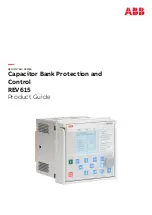
6.1.3.4
Monitoring recorded data
Some functions, for example, distance protection and fault locator, include data
recording functionality. All the information required for later fault analysis is
recorded when the function is triggered either internally or externally.
One or three sets of recorded data are available saved in data banks 1-3. The data bank
1 always holds the most recent recorded data. When a new triggering occurs, older
data is moved into the next banks (from 1 to 2, and from 2 to 3). When all three banks
already contain data, and a new triggering occurs, the data in bank 3 is overwritten.
For some functions, only one set of recorded data is available. In this case, the
recorded data always overwrites the older data in data bank 1.
1.
Select
Main menu/Monitoring/I/O status/Protection/[Protection type]/
[Function]/Recorded data
.
2.
To navigate between the fault records, press
and
.
3.
To enter or exit a submenu, press
or
.
GUID-B823C111-DEE3-45B4-B1E5-B384F2AB9368 V1 EN
Figure 53:
Monitoring fault records
Monitoring fault locator data
When the fault locator function is triggered, fault location data is output. The data is
kept unchanged until the next triggering or reset.
•
To monitor fault locator data, select
Main menu/Monitoring/I/O status/
Protection/Current protection/SCERFLO/Recorded data
.
There are three data banks for the recorded data. The most recent information is
always found in the first data bank.
Section 6
1MRS756509 E
Operating procedures
72
630 series
Operation Manual
















































